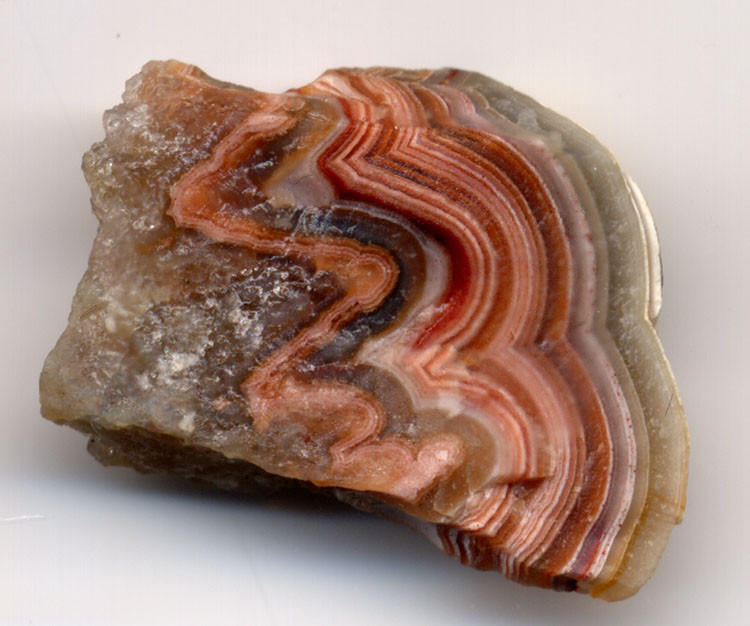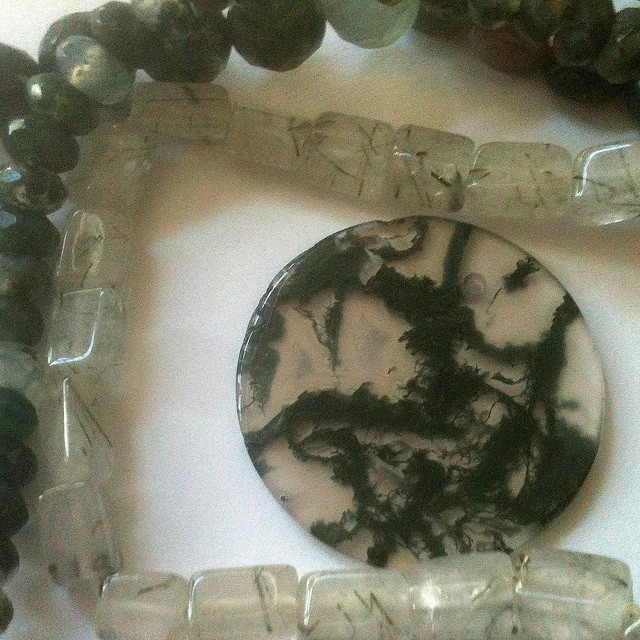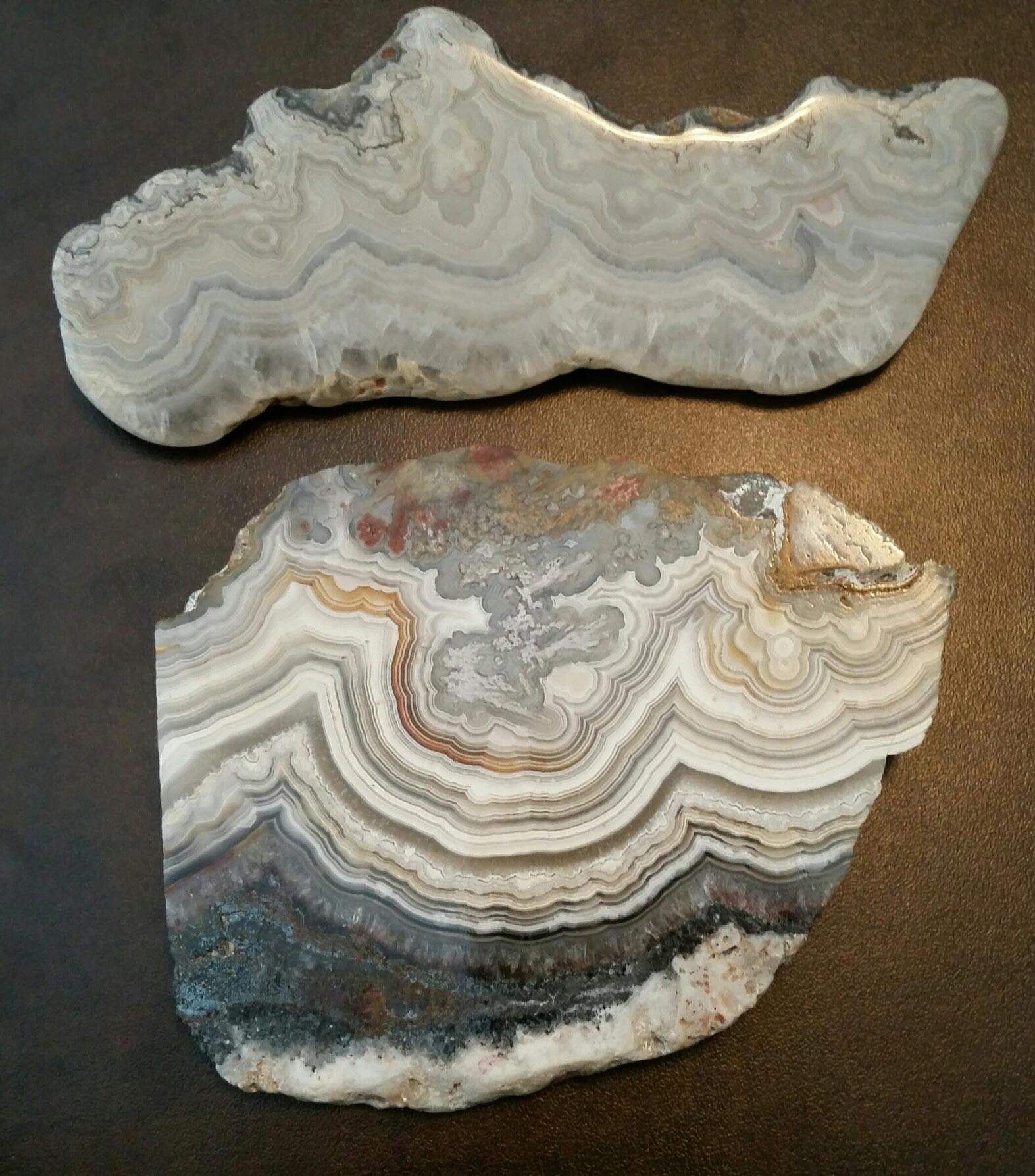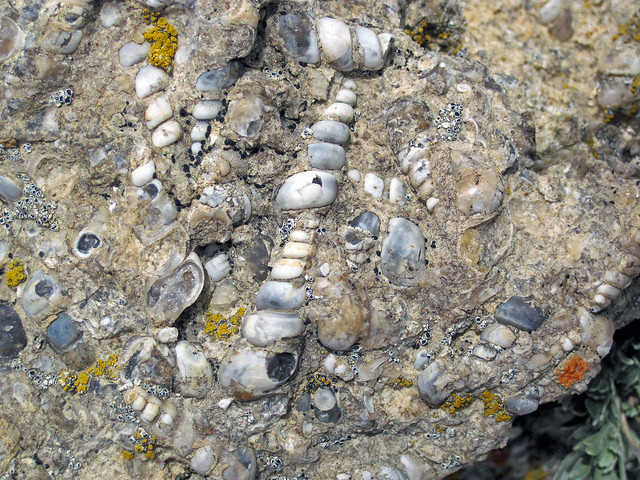Are Agate Rocks Worth Money? Absolutely, agate rocks can be worth money, especially those with unique patterns, vibrant colors, and exceptional quality, as you’ll discover at rockscapes.net. We’ll delve into what makes these beautiful stones valuable, exploring their types, origins, and the factors that influence their worth. Get ready to uncover the secrets of agate value and how you can appreciate these natural treasures even more with rockscapes.net.
1. What is Agate and Why Does It Matter?
Is agate just another pretty rock? No, agate is a captivating variety of chalcedony, a cryptocrystalline form of quartz, celebrated for its diverse colors, intricate patterns, and intriguing inclusions. Its beauty lies in the unique formations and the stories they tell, making it a prized possession for collectors, jewelers, and anyone who appreciates the wonders of nature, and at rockscapes.net, we help you bring this beauty into your landscaping.
1.1 The Science Behind Agate
What makes agate so special on a scientific level? Agate’s composition as a form of chalcedony means it’s primarily silicon dioxide (SiO2). The presence of trace elements such as iron, manganese, titanium, chromium, and nickel oxides results in a wide array of colors. According to research from Arizona State University’s School of Earth and Space Exploration, the specific concentration and distribution of these elements during the agate’s formation process determine its unique banding and patterns.
1.2 Key Characteristics of Agate
What are the defining traits of agate? Here’s a breakdown:
- Translucency: Agate can range from opaque to translucent, and in rare cases, even transparent.
- Color: Vivid colors result from trace elements, offering a spectrum of possibilities.
- Polish: Agate takes an exceptional polish, enhancing its visual appeal.
- Durability: With a hardness of 6.5 to 7 on the Mohs scale, agate is durable enough for most jewelry applications.
- Patterns: Intriguing patterns, whether banded, moss-like, or scenic, make each piece unique.
1.3 The Allure of Agate in Landscaping
Why use agate in landscaping? Agate’s durability and aesthetic appeal make it an excellent choice for various landscaping applications. From decorative stones in garden beds to eye-catching features in water features, agate adds a touch of natural elegance and sophistication to any outdoor space. With rockscapes.net, you can explore endless possibilities for incorporating agate into your landscape designs.
2. Exploring the Diverse Varieties of Agate
What are the different types of agate? The world of agate is incredibly diverse, with each variety showcasing unique characteristics. Gemologists categorize agates based on color patterns, inclusions, and geographic origin. Let’s explore some of the most stunning and sought-after types.
2.1 Banded Agate: A Classic Beauty
What makes banded agate so popular? Banded agates feature regular, concentric layers of color, creating a visually striking effect. These layers are formed by the deposition of different mineral-rich solutions over time. While banded agates are found worldwide, Brazil is renowned as a major source.
 Banded Agate Specimen
Banded Agate Specimen
2.2 Moss, Plume, and Dendritic Agate: Nature’s Artistry
What sets these agates apart? Moss, plume, and dendritic agates are celebrated for their unique inclusions of mineral oxides, which create patterns resembling plants, feathers, and trees.
- Moss Agate: Features plant-like patterns.
- Plume Agate: Showcases feather-like formations.
- Dendritic Agate: Displays tree-like, branching patterns.
 Moss Agate
Moss Agate
2.3 Picture or Scenic Agate: Landscapes in Stone
What makes picture agates so special? Picture agates contain inclusions that create the illusion of miniature landscapes, complete with lakes, shorelines, trees, and shrubs. These “natural picture” stones are highly treasured by collectors for their unique and captivating imagery.
2.4 Fire Agate: Iridescent Wonders
What causes the fire in fire agate? Fire agates exhibit stunning iridescence due to inclusions of plate-like crystals of iron hydroxides, known as limonite. The careful cutting and polishing of these stones enhance this mesmerizing effect, making them highly desirable.
2.5 Lace Agate: Delicate Designs
What is so captivating about lace agate? Lace agates are characterized by delicate, intricate patterns of swirls and loops. These formations create a lacy appearance that is both elegant and visually appealing. Mexico is one of the primary sources of this exquisite material.
 Lace Agates
Lace Agates
2.6 Other Notable Agate Varieties
What other types of agate are worth knowing about? Here are a few more varieties that deserve attention:
- Iris Agate: Displays iridescent colors between color layers.
- Shell Agate: Features patterns created by embedded, silicified shells.
- Turritella Agate: Consists primarily of shells and shell fragments of the gastropod genus Turritella.
- Petrified Wood Agate: Formed when ancient tree trunks and limbs have their organic components replaced by agate over millions of years.
 Turritella Agate
Turritella Agate
3. Agate Formation: A Geological Masterpiece
How do agates actually form? Agates typically form within volcanic rocks or ancient lava flows. The process begins with gas bubbles trapped inside the cooling lava. Over time, silica-rich groundwater seeps into these cavities, depositing layers of chalcedony. The varying concentrations of minerals and trace elements in the water create the distinct banding and patterns that characterize agates.
3.1 The Role of Chalcedony
What is chalcedony’s role in agate formation? Chalcedony is the primary mineral component of agate, providing the base structure for its formation. It is a microcrystalline form of quartz, meaning its crystals are too small to be seen with the naked eye. This fine-grained structure allows for the intricate patterns and smooth textures that make agate so appealing.
3.2 The Influence of Trace Elements
How do trace elements affect agate’s appearance? Trace elements such as iron, manganese, titanium, chromium, and nickel oxides play a crucial role in determining the color and patterns of agate. These elements enter the silica-rich groundwater and are deposited along with the chalcedony, creating the vibrant hues and unique formations that define each variety of agate.
3.3 The Formation Process: A Step-by-Step Overview
Can you break down the formation process? Here’s a simplified look at how agates are formed:
- Volcanic Activity: Agates often begin their formation within volcanic rocks.
- Gas Bubbles: Gas bubbles trapped in cooling lava create cavities.
- Groundwater Seepage: Silica-rich groundwater seeps into these cavities.
- Chalcedony Deposition: Layers of chalcedony are deposited, forming bands and patterns.
- Trace Element Influence: Varying concentrations of minerals and trace elements create colors and formations.
- Millions of Years: The process occurs over millions of years, resulting in the unique agate formations we admire today.
4. What Determines Agate Value?
What makes one agate more valuable than another? Several factors influence the value of agate stones. Understanding these elements can help you appreciate the true worth of these natural treasures and make informed decisions when buying or collecting.
4.1 Color and Pattern
How do color and pattern impact value? The color and pattern of an agate are primary determinants of its value. Agates with vibrant, distinct colors and intricate, eye-catching patterns tend to command higher prices. Unique formations, such as those found in picture agates, are particularly prized.
4.2 Size and Quality
Do size and quality matter? Yes, larger agates of exceptional quality are more valuable. The size of the agate allows for a more detailed display of its patterns and colors. Quality refers to the absence of cracks, flaws, and imperfections, as well as the overall polish and finish of the stone.
4.3 Rarity and Origin
How does rarity play a role? Rare agate varieties, such as those from specific locations or with unique inclusions, are highly sought after by collectors. The origin of the agate can also influence its value, with stones from renowned locations often fetching higher prices due to their reputation for quality and beauty.
4.4 Craftsmanship and Artistry
How much does artistry contribute to value? The craftsmanship and artistry involved in cutting, polishing, and setting an agate significantly impact its value. Custom-cut pieces and stones set in fine jewelry demonstrate the skill and creativity of the artisan, adding to their overall worth.
4.5 Market Demand
Does popularity drive up the price? Yes, market demand plays a crucial role in determining the value of agate. As with any commodity, increased demand for specific varieties or styles of agate can drive up prices. Collectors, jewelers, and designers all contribute to market demand, influencing the overall value of these stones.
5. Agate Enhancements: What You Need to Know
Are all agates completely natural? While many agates are sold in their natural state, enhancements are common in the gem and jewelry industry. Understanding these enhancements is essential for making informed decisions when buying agate.
5.1 Dyeing: Enhancing Color
Why are some agates so brightly colored? Dyeing is a common enhancement technique used to intensify or alter the color of agate. Chalcedony is porous, making it easy to dye. The process involves soaking the agate in a dye solution, which penetrates the stone and enhances its color.
5.2 Historical Dyeing Techniques
How did they dye agates in the past? The art of dyeing agates has a rich history, with techniques dating back centuries. One of the most celebrated dyeing processes originated in Idar-Oberstein, Germany, during the 19th century. This secret process involved shipping gray agates from South America back to Idar-Oberstein for dyeing, resulting in extraordinarily colored stones.
5.3 Ethical Considerations
Is it ethical to dye agates? Transparency is key. Ethical gem dealers always disclose any enhancements to consumers, including dyeing. This ensures marketplace transparency and allows buyers to make informed decisions based on their preferences and values.
6. Global Sources of Agate: Where Do They Come From?
Where are agates found around the world? Agate stones are found in various locations worldwide, each offering unique varieties and characteristics. Here are some notable sources:
6.1 Brazil
What types of agate come from Brazil? Brazil is renowned as one of the most productive sources of banded agate. The country’s rich geological history and diverse mineral deposits contribute to the formation of high-quality agates with stunning colors and patterns.
6.2 Mexico
What kind of agate is Mexico known for? Mexico is a premier source of lace agate and fire agate. The delicate, intricate patterns of lace agate and the iridescent beauty of fire agate make these stones highly sought after by collectors and jewelers alike.
6.3 United States
What kinds of agate can be found in the USA? The United States offers a variety of agate sources, including:
- Moss Agate: Northwestern United States
- Scenic Agate: Yellowstone National Park, Wyoming, Montana
- Banded Agate: Various locations across the country
- Petrified Wood: Arizona, New Mexico, California
6.4 Other Notable Locations
Where else can you find agate? Other notable locations for agate include:
- India: Moss Agate
- Scotland: Moss Agate
- Madagascar: Banded Agate
- Namibia: Lace Agate
- Uruguay: Banded Agate
- Various European Countries: Petrified Wood
7. Agate in Jewelry and Design: A Timeless Appeal
How is agate used in jewelry and design? Agate’s beauty, durability, and versatility make it a popular choice for jewelry and design applications. From statement necklaces to elegant rings, agate adds a touch of natural elegance to any piece.
7.1 Agate Pendants and Necklaces
What makes agate pendants so appealing? Agate pendants and necklaces showcase the stone’s unique patterns and colors, creating a focal point for any outfit. The smooth, polished surface of agate feels comfortable against the skin, making it a pleasure to wear.
7.2 Agate Rings and Earrings
How does agate enhance rings and earrings? Agate rings and earrings add a touch of sophistication and natural beauty to any ensemble. The stone’s durability ensures that it can withstand daily wear, while its unique patterns make each piece one-of-a-kind.
7.3 Agate in Home Decor
Can agate be used in home decor? Yes, agate can be incorporated into home decor in various ways. Agate slices can be used as coasters, decorative trays, or wall art, adding a touch of natural elegance to any space. Larger agate pieces can be used as statement pieces on shelves or coffee tables, creating a focal point for the room.
8. Agate in Landscaping: Enhancing Outdoor Spaces
How can agate enhance my landscape? Agate’s durability and aesthetic appeal make it an excellent choice for various landscaping applications. From decorative stones in garden beds to eye-catching features in water features, agate adds a touch of natural elegance and sophistication to any outdoor space.
8.1 Decorative Stones in Garden Beds
How can I use agate in my garden? Agate stones can be used as decorative elements in garden beds, adding color, texture, and visual interest to your landscape. The stones can be arranged in patterns or scattered randomly, depending on your design preferences.
8.2 Water Features and Rock Gardens
How does agate complement water features? Agate’s smooth, polished surface and vibrant colors make it an ideal choice for water features and rock gardens. The stones can be placed around the edges of ponds or streams, adding a touch of natural beauty to the water’s edge.
8.3 Pathways and Walkways
Can agate be used for pathways? Yes, smaller agate pieces can be used to create pathways and walkways in your garden. The stones can be embedded in concrete or arranged loosely to create a natural, rustic look.
8.4 Incorporating Agate with rockscapes.net
How can rockscapes.net help me with agate landscaping? At rockscapes.net, we offer a wide selection of agate stones for all your landscaping needs. Whether you’re looking for decorative stones for your garden beds or statement pieces for your water features, we have the perfect agate to enhance your outdoor space. Visit our website to explore our collection and get inspired.
9. Caring for Your Agate: Tips for Longevity
How do I care for my agate to keep it looking its best? Proper care is essential for maintaining the beauty and longevity of your agate stones. Here are some tips for caring for your agate:
9.1 Cleaning
How should I clean my agate jewelry? Clean agate jewelry with a soft cloth and mild soap. Avoid harsh chemicals and abrasive cleaners, which can damage the stone’s surface. Rinse thoroughly with water and dry with a soft cloth.
9.2 Storage
How should I store my agate pieces? Store agate jewelry in a soft pouch or jewelry box to protect it from scratches and damage. Keep it separate from other jewelry to prevent it from scratching softer stones.
9.3 Avoiding Harsh Chemicals
What should I avoid when handling agate? Avoid exposing agate to harsh chemicals, such as household cleaners, perfumes, and hairsprays. These chemicals can damage the stone’s surface and affect its color.
9.4 Protecting from Impact
How can I protect agate from damage? While agate is relatively durable, it can still be damaged by impact. Avoid dropping or hitting agate against hard surfaces. Remove agate jewelry before engaging in activities that could potentially damage it.
10. Frequently Asked Questions About Agate
Do you have more questions about agate? Here are some frequently asked questions to help you understand more about this fascinating gemstone:
10.1 What Exactly is an Agate Stone?
What is the geological definition of agate? Geologically, agate is defined as a variety of chalcedony, a cryptocrystalline form of quartz. Its distinctive colors, patterns, inclusions, and degrees of translucence make it unique. Traces of iron, manganese, titanium, and chromium oxides contribute to its coloration.
10.2 How Are Agates Typically Valued?
What factors influence agate’s value? Agates are valued based on the skill and artistic work involved in creating the finished jewelry, rather than the raw material’s inherent worth. Larger agates with distinctive, fine, or landscape-like color patterns command higher prices. Custom-cut stones or those from prized locations also fetch premium prices.
10.3 What Are the Most Common Varieties of Agate?
What are some popular types of agate? Some popular varieties include:
- Banded Agates with regular color layers
- Moss Agates with plant-like patterns
- Plume Agates featuring feather-like formations
- Dendritic Agates with tree-like branching patterns
- Picture or Scenic Agates showing landscape-like inclusions
- Fire Agates with iridescent limonite crystals
- Lace Agates with intricate swirls and loops
10.4 Where Are Agates Typically Found?
Where can I find agate around the world? Agates are found in many locations worldwide. Brazil is a significant source of banded agates, while Mexico is known for lace agates.
10.5 What Are the Most Common Enhancements for Agates?
Are agates always natural? Dyeing is a primary enhancement technique for agates. Chalcedony stones’ porous structure allows them to absorb dyes easily.
10.6 Can Agates Form in Large Sizes?
Do agates come in big sizes? Gem hunters typically find agates as small nodules. However, these stones can occasionally grow into massive formations weighing several pounds.
10.7 Are All Agates Naturally Colored?
Are agate’s colors always natural? Many agates undergo commercial dyeing processes. Banded agates, in particular, often feature artificially enhanced colors. Ethical gem dealers always disclose these enhancements.
10.8 How Can rockscapes.net Help Me Choose the Right Agate?
What resources does rockscapes.net offer? At rockscapes.net, we provide a wealth of information and resources to help you choose the right agate for your needs. Whether you’re looking for landscaping ideas, detailed information about different types of agate, or expert advice, we have you covered.
10.9 What Are the Benefits of Using Agate in Landscaping?
Why should I use agate in my landscape? Agate offers several benefits for landscaping, including its durability, aesthetic appeal, and versatility. It can be used in garden beds, water features, pathways, and more, adding a touch of natural elegance to any outdoor space.
10.10 Where Can I Purchase High-Quality Agate Stones?
Where can I buy agate? You can purchase high-quality agate stones from rockscapes.net. We offer a wide selection of agate stones for all your landscaping and design needs. Visit our website to explore our collection and find the perfect agate for your project.
Agate rocks can indeed be worth money, but their true value lies in their beauty, uniqueness, and the joy they bring to collectors and enthusiasts. Whether you’re a seasoned gem collector or simply someone who appreciates the wonders of nature, agate offers endless opportunities for discovery and inspiration. Explore the world of agate with rockscapes.net and unlock the beauty of these natural treasures for your landscaping and design projects. Contact us at Address: 1151 S Forest Ave, Tempe, AZ 85281, United States, Phone: +1 (480) 965-9011, or visit our website rockscapes.net today!
